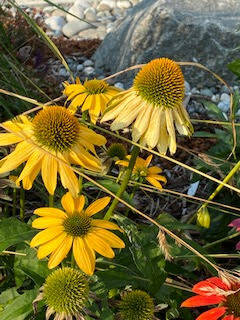Sept. 23 marked the Autumnal Equinox, the day the sun crosses the celestial equator and fall officially begins. The sun’s path is now lower in the sky, causing the northern hemisphere to receive less light and heat. This makes the days shorter and colder.
Garden maintenance
Now is the time to pull up, cut back, and compost anything that no longer looks good or is not producing, being careful not to compost anything with weed, seed, or disease. Continue to deadhead plants that are still blooming. Rake leaves off lawns and chop them up to use as mulch or compost them.
Weeds, unfortunately, are a yearlong chore. Waiting for a little rain may be a good strategy for weeding. The softer the ground, the easier it is to get the roots. Don’t wait for spring; tackle tough perennial weeds to keep their roots from getting stronger and deeper.
Once done, discourage all weeds by covering areas with some type of weed barrier, whether it is thick mulch, cardboard, or temporary black plastic. Whichever material you choose, it should be thick enough to block any light.
Weeds are not the only pests you can discourage from returning in spring. Slugs, snails, aphids and other annoying pests love to overwinter in the garden. Removing weeds and dead plant material is the first step. Continue by removing any old pots, plastic, brick, boards or other debris that may offer shelter to unwanted, over-wintering pests.
Bulbs, corms, rhizomes, tubers
Beginning mid-month, plant spring flowering bulbs. When night temperatures drop into the 40s, dig up and dry tubers of cannas, elephant ears, and tuberous begonias and store them in sawdust, peat, or newspaper in a cool dark place. Dahlia tubers and gladiolus corms can be left in the ground or dug up after the first hard frost.
If you leave dahlias in the ground, cut down the foliage and cover each with a plastic nursery pot and mulch with at least 6 inches of material such as straw or leaves. Cut the dead leaves from gladiolus and cover with at least 4 inches of mulch. To be safe, or if you live in higher elevations, you may wish to dig dahlias and gladiolus up and store them in sawdust in a cool dark place.
Water
The winter rain may not provide a constant amount of water, so keep an eye on ground and container moisture. If you have a lot of your garden in pots or under cover, keep up with watering. Any newly planted or transplanted, trees, shrubs or perennials are establishing roots and need adequate moisture.
Shrubs, trees
Plant new shrubs and trees now and water them well until adequate rain arrives. In the spring and following summer months continue to water these new plants for at least a year, regardless if they are native or drought resistant. While plants may survive, they will not become well established or thrive without supplemental water.
Transplant deciduous trees and shrubs after their leaves have fallen. Add mulch around new plantings to retain moisture and to provide nutrients as the mulch decomposes. Treat transplanted plants as if they were new.
Water existing plantings as needed but do not fertilize or prune them. Doing so may encourage tender new growth that will be subjected to winter weather.
Edible garden
The last of the apples will be ready when the seeds turn brown. Pears should be harvested when full-sized and left to ripen. Clean up fallen fruit, leaves, and other debris under trees.
As mentioned in the last column, October is the time to get the garlic planted. Come spring, you will be welcoming strong plants that will be ready to harvest later in summer. By month-end, add other aromatic vegetables such as multiplier onions and shallots along with the garlic.
Mulch beds that won’t hold winter or cover crops. Mulch fall and winter vegetables for frost protection.
While October may be the time to clean up the garden in earnest, a good gardener is always planning ahead. The upside to cleaning is the possibility of preparing new beds (thus buying more plants and seeds!). Use newspaper or cardboard to cover an area you want to convert to a new planting area or raised bed. Use the leaves and other chopped materials headed for the compost as a cover (and deep as possible). Let nature keep the weeds out and start planning what to grow come spring.
Just remember, the chances are, whatever doesn’t get done this fall is going to be a much muddier chore come March.
Susan Kalmar is a Clallam County Master Gardener.
Branches a boon to bees, beetles
Allowing a small pile of branches and other woody debris to remain will encourage some bees and ground beetles to take shelter. These do a wonderful job of controlling many undesirable insect pests. Mason bees and other beneficial pollinators can also take shelter in purposely arranged habitat.
October educational opportunities
Clallam County Master Gardeners have two interesting educational programs lined up in October: Two Green Thumb Presentations will be offered in the Carver Room of the Port Angeles Library (2210 S. Peabody St.); both start at noon. On Thursday, Oct. 12, check out “Asexual Propagation” presented by Iris Fagerland from Earth Grown Creations Nursery. On Thursday, Oct. 28: Master Gardener Sara Farinelli offers “Propagating Ferns.” Dates and topics could change. For more detailed information, visit clallammgf.org.


